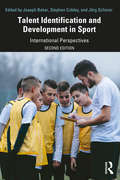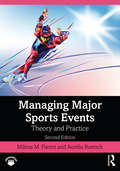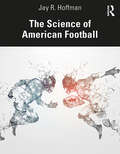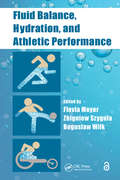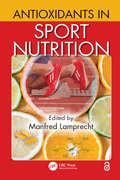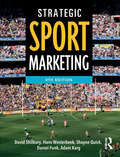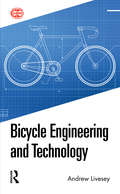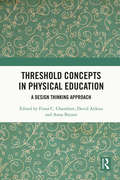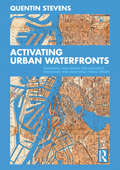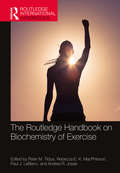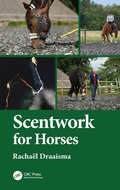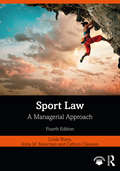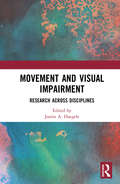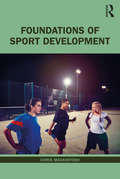- Table View
- List View
Talent Identification and Development in Sport: International Perspectives
by Joseph Baker, Stephen Cobley, and Jörg SchorerIdentifying and developing talented athletes to their fullest potential is a central concern of sport scientists, sports coaches, and sports policy makers. The second edition of this popular text offers a state of the science synthesis of current knowledge in talent identification and development in sport, from the biological basis of talent to the systems and processes within sport through which that talent is nurtured. Written by a team of leading international experts, the book explores key factors and issues in contemporary sport, including: nature and nurture in the development of sporting talent designing optimal developmental environments long-term modelling of athlete development understanding the complexity of talent selection in-depth case studies of successful talent development systems. With an emphasis on practical implications for all those working in sport, the book offers an authoritative evaluation of the strengths and weaknesses of contemporary systems for identifying and developing talent in sport. This is important reading for any student, researcher, or practitioner with an interest in skill acquisition, youth sport, elite sport, sports coaching, or sports development.
Managing Major Sports Events: Theory and Practice
by Milena M. Parent Aurélia RuetschManaging Major Sports Events: Theory and Practice is a complete introduction to the principles and practical skills that underpin the running and hosting of major sports events, from initial bid to post-event legacy and sustainability. Now in a fully-revised and updated new edition, the book draws on the latest research from across multiple disciplines; explores real-world situations, and emphasises practical problem-solving skills. It covers every key area in the event management process, including: • Bidding, leadership, and planning • Marketing and human resource management • Venues and ceremonies • Communications and technology (including social media) • Functional area considerations (including sport, protocol, and event services) • Security and risk management • Games-time considerations • Event wrap-up and evaluation • Legacy and sustainability This revised edition includes expanded coverage of cutting-edge topics such as digital media, culture, human resources, the volunteer workforce, readiness, security, and managing Games-time. Each chapter combines theory, practical decision-making exercises and case studies of major sports events from around the world, helping students and practitioners alike to understand and prepare for the reality of executing major events on an international scale. Also new to this edition is an &‘Outlook, Trends and Innovations&’ section in each chapter, plus &‘tips&’ by leading events professionals. Managing Major Sports Events: Theory and Practice is an essential textbook for any course on sports event management or international sports management, and an invaluable resource for all sport management researchers, practitioners and policy-makers. Online resources include PowerPoint slides, multiple choice questions, essay questions and decision-making exercises.
Managing Major Sports Events: Theory and Practice
by Milena M. Parent Aurélia RuetschManaging Major Sports Events: Theory and Practice is a complete introduction to the principles and practical skills that underpin the running and hosting of major sports events, from initial bid to post-event legacy and sustainability. Now in a fully-revised and updated new edition, the book draws on the latest research from across multiple disciplines; explores real-world situations, and emphasises practical problem-solving skills. It covers every key area in the event management process, including: • Bidding, leadership, and planning • Marketing and human resource management • Venues and ceremonies • Communications and technology (including social media) • Functional area considerations (including sport, protocol, and event services) • Security and risk management • Games-time considerations • Event wrap-up and evaluation • Legacy and sustainability This revised edition includes expanded coverage of cutting-edge topics such as digital media, culture, human resources, the volunteer workforce, readiness, security, and managing Games-time. Each chapter combines theory, practical decision-making exercises and case studies of major sports events from around the world, helping students and practitioners alike to understand and prepare for the reality of executing major events on an international scale. Also new to this edition is an &‘Outlook, Trends and Innovations&’ section in each chapter, plus &‘tips&’ by leading events professionals. Managing Major Sports Events: Theory and Practice is an essential textbook for any course on sports event management or international sports management, and an invaluable resource for all sport management researchers, practitioners and policy-makers. Online resources include PowerPoint slides, multiple choice questions, essay questions and decision-making exercises.
The Science of American Football
by Jay R. HoffmanThe game of American football may be the greatest team sport that exists. It epitomizes the need of a "team" first approach to achieve the desired success. Success is often measured as the hoisting of a championship trophy, which involved a journey that required discipline, perseverance, sacrifice, and hard work. These traits are the backbone of success in football, but more importantly they are the backbone or blueprint for success in life. The Science of American Football provides an in-depth discussion on the physiology of the game of American football, including the physiological strain associated with playing in various environmental extremes. Acclimatization, preparation, and medical issues associated with each of these environmental extremes are discussed as well as medical issues occurring during the athlete’s playing career (common sites of injury) and potential risks arising post-career (e.g. neurological dysfunction, arthritic joints, obesity). The book goes on to consider aspects of player selection and preparation, including discussion of evidence-based physical conditioning programs, appropriate nutrition, and specific dietary supplementation for the American football player. The Science of American Football is the first book to focus on the physiology, science, and medical issues associated with the game of American football and will be key reading for students of coaching and exercise science as well as those with a keen interest in understanding the science of American football, such as coaches and players.
The Science of American Football
by Jay R. HoffmanThe game of American football may be the greatest team sport that exists. It epitomizes the need of a "team" first approach to achieve the desired success. Success is often measured as the hoisting of a championship trophy, which involved a journey that required discipline, perseverance, sacrifice, and hard work. These traits are the backbone of success in football, but more importantly they are the backbone or blueprint for success in life. The Science of American Football provides an in-depth discussion on the physiology of the game of American football, including the physiological strain associated with playing in various environmental extremes. Acclimatization, preparation, and medical issues associated with each of these environmental extremes are discussed as well as medical issues occurring during the athlete’s playing career (common sites of injury) and potential risks arising post-career (e.g. neurological dysfunction, arthritic joints, obesity). The book goes on to consider aspects of player selection and preparation, including discussion of evidence-based physical conditioning programs, appropriate nutrition, and specific dietary supplementation for the American football player. The Science of American Football is the first book to focus on the physiology, science, and medical issues associated with the game of American football and will be key reading for students of coaching and exercise science as well as those with a keen interest in understanding the science of American football, such as coaches and players.
Fluid Balance, Hydration, and Athletic Performance
by Flavia MeyerAthletes and nonathletes frequently consume too little water or fluids, affecting exercise performance as well as overall health. This book comprehensively reviews the aspects relating to body fluid balance, rehydration, and physical exercise. It provides background on body water balance and turnover, topics related to electrolyte balance, and sweating as the basis for thermoregulatory and fluid homeostasis during exercise. In addition, chapters cover body water balance evaluation and regulation; cardiovascular and metabolic responses to fluid imbalance; effects of dehydration on aerobic power, muscle strength, and cognitive function; fluid intake timing; and optimal beverage selection.
Antioxidants in Sport Nutrition
by Manfred LamprechtAntioxidant use in sports is controversial due to existing evidence that it both supports and hurts athletic performance. This book presents information on antioxidants, specifically for athletes, and their roles in sports nutrition. It stresses how antioxidants affect exercise performance, health, and immunity. Chapters cover oxidative stress; basic nutrition for athletes; major dietary antioxidants; sports supplements; performance/adaptation to exercise; antioxidants role in health and immunity; reviews on vitamins C, E, beta-carotene, and minerals in sports nutrition; and roles polyphenols play in high-performance sport.
Strategic Sport Marketing
by David Shilbury Shayne Quick Daniel Funk Hans Westerbeek Adam KargSport now has to compete for the consumer dollar with a vast array of leisure activities online as well as offline. Successful sport marketing is the result of carefully structured planning, creativity and perseverance.Integrating the unique characteristics of sport with traditional marketing theory, Strategic Sport Marketing presents a framework of strategic decision-making. The authors outline the diverse markets for sport: participants, sponsors, spectators and fans. International case studies and 'sportviews' selected from a wide range of sports and media illustrate the unique features of sport marketing.Strategic Sport Marketing is a practical tool and theoretical guide to sport marketing internationally. The fourth edition of this widely used text is fully revised and updated. It includes new material on sports promotion, customer service and social media, as well as new case studies.'A sport marketing text at the undergraduate level needs to engage both student and teacher. . . I believe Strategic Sport Marketing does this rather well.' - Sport Management Review'. . . a comprehensive illustration of the integration of sport marketing theory with sport marketing practice.' - Journal of Sport Management
Strategic Sport Marketing
by David Shilbury Shayne Quick Daniel Funk Hans Westerbeek Adam KargSport now has to compete for the consumer dollar with a vast array of leisure activities online as well as offline. Successful sport marketing is the result of carefully structured planning, creativity and perseverance.Integrating the unique characteristics of sport with traditional marketing theory, Strategic Sport Marketing presents a framework of strategic decision-making. The authors outline the diverse markets for sport: participants, sponsors, spectators and fans. International case studies and 'sportviews' selected from a wide range of sports and media illustrate the unique features of sport marketing.Strategic Sport Marketing is a practical tool and theoretical guide to sport marketing internationally. The fourth edition of this widely used text is fully revised and updated. It includes new material on sports promotion, customer service and social media, as well as new case studies.'A sport marketing text at the undergraduate level needs to engage both student and teacher. . . I believe Strategic Sport Marketing does this rather well.' - Sport Management Review'. . . a comprehensive illustration of the integration of sport marketing theory with sport marketing practice.' - Journal of Sport Management
Bicycle Engineering and Technology
by Andrew LiveseyBicycle Engineering and Technology is a primer and technical introduction for anyone interested in bicycles, bicycling and the bicycle industry. With insight into how bicycles are made and operated, the book covers the engineering materials used for their manufacture and the technicalities of riding. It also discusses ways in which the enthusiast may wish to get involved in the business of working with these fantastic machines, which are now being aided with electrical power. The bicycle is a significant factor in transportation around the world and is playing an increasingly crucial role in transport policy as we collectively become more environmentally conscious. To celebrate the importance of the bicycle on the world stage, a brief history is included along with a detailed timeline showing the development of the bicycle with major world events. Previous knowledge of engineering or technology is not required to enjoy this text, as all technical terms are explained and a full glossary and lists of abbreviations are included. Whether you are a bicycling enthusiast, racer, student or bicycle professional, you will surely want to read it and keep it on your shelf as a handy reference.
Bicycle Engineering and Technology
by Andrew LiveseyBicycle Engineering and Technology is a primer and technical introduction for anyone interested in bicycles, bicycling and the bicycle industry. With insight into how bicycles are made and operated, the book covers the engineering materials used for their manufacture and the technicalities of riding. It also discusses ways in which the enthusiast may wish to get involved in the business of working with these fantastic machines, which are now being aided with electrical power. The bicycle is a significant factor in transportation around the world and is playing an increasingly crucial role in transport policy as we collectively become more environmentally conscious. To celebrate the importance of the bicycle on the world stage, a brief history is included along with a detailed timeline showing the development of the bicycle with major world events. Previous knowledge of engineering or technology is not required to enjoy this text, as all technical terms are explained and a full glossary and lists of abbreviations are included. Whether you are a bicycling enthusiast, racer, student or bicycle professional, you will surely want to read it and keep it on your shelf as a handy reference.
Threshold Concepts in Physical Education: A Design Thinking Approach
by Fiona C. Chambers David Aldous Anna BryantThis innovative and user-friendly book uses a design thinking approach to examine transformative learning and liminality in physical education. Covering theory and practice, it introduces the important idea of ‘threshold concepts’ for physical education, helping physical educators to introduce those concepts into curriculum, pedagogy and assessment. The book invites us to reflect on what is learned in, through and about physical education - to identify its core threshold concepts. Once identified, the book explains how the learning of threshold concepts can be planned using principles of pedagogical translation for all four learning domains (cognitive, psychomotor, affective and social). The book is arranged into three key sections which walk the reader through the underpinning concepts, use movement case studies to explore and generate threshold concepts in physical education using design thinking approach and, finally, provide a guiding Praxis Matrix for PE Threshold Concepts that can be used for physical educators across a range of school and physical activity learning contexts. Outlining fundamental theory and useful, practical teaching and coaching advice, this book is invaluable reading for all PE teacher educators, coach educators, and any advanced student, coach or teacher looking to enrich their knowledge and professional practice.
Threshold Concepts in Physical Education: A Design Thinking Approach
by Fiona C. Chambers David Aldous Anna BryantThis innovative and user-friendly book uses a design thinking approach to examine transformative learning and liminality in physical education. Covering theory and practice, it introduces the important idea of ‘threshold concepts’ for physical education, helping physical educators to introduce those concepts into curriculum, pedagogy and assessment. The book invites us to reflect on what is learned in, through and about physical education - to identify its core threshold concepts. Once identified, the book explains how the learning of threshold concepts can be planned using principles of pedagogical translation for all four learning domains (cognitive, psychomotor, affective and social). The book is arranged into three key sections which walk the reader through the underpinning concepts, use movement case studies to explore and generate threshold concepts in physical education using design thinking approach and, finally, provide a guiding Praxis Matrix for PE Threshold Concepts that can be used for physical educators across a range of school and physical activity learning contexts. Outlining fundamental theory and useful, practical teaching and coaching advice, this book is invaluable reading for all PE teacher educators, coach educators, and any advanced student, coach or teacher looking to enrich their knowledge and professional practice.
Activating Urban Waterfronts: Planning and Design for Inclusive, Engaging and Adaptable Public Spaces
by Quentin StevensActivating Urban Waterfronts shows how urban waterfronts can be designed, managed and used in ways that can make them more inclusive, lively and sustainable. The book draws on detailed examination of a diversity of waterfronts from cities across Europe, Australia and Asia, illustrating the challenges of connecting these waterfront precincts to the surrounding city and examining how well they actually provide connection to water. The book challenges conventional large scale, long-term approaches to waterfront redevelopment, presenting a broad re-thinking of the formats and processes through which urban redevelopment can happen. It examines a range of actions that transform and activate urban spaces, including informal appropriations, temporary interventions, co-design, creative programming of uses, and adaptive redevelopment of waterfronts over time. It will be of interest to anyone involved in the development and management of waterfront precincts, including entrepreneurs, the creative industries, community organizations, and, most importantly, ordinary users.
Activating Urban Waterfronts: Planning and Design for Inclusive, Engaging and Adaptable Public Spaces
by Quentin StevensActivating Urban Waterfronts shows how urban waterfronts can be designed, managed and used in ways that can make them more inclusive, lively and sustainable. The book draws on detailed examination of a diversity of waterfronts from cities across Europe, Australia and Asia, illustrating the challenges of connecting these waterfront precincts to the surrounding city and examining how well they actually provide connection to water. The book challenges conventional large scale, long-term approaches to waterfront redevelopment, presenting a broad re-thinking of the formats and processes through which urban redevelopment can happen. It examines a range of actions that transform and activate urban spaces, including informal appropriations, temporary interventions, co-design, creative programming of uses, and adaptive redevelopment of waterfronts over time. It will be of interest to anyone involved in the development and management of waterfront precincts, including entrepreneurs, the creative industries, community organizations, and, most importantly, ordinary users.
The Routledge Handbook on Biochemistry of Exercise (Routledge International Handbooks)
by Peter M. Tiidus Rebecca E. K. MacPherson Paul J. LeBlanc Andrea R. JosseFrom its early beginnings in the 1960s, the academic field of biochemistry of exercise has expanded beyond examining and describing metabolic responses to exercise and adaptations to training to include a wide understanding of molecular biology, cell signalling, interorgan communication, stem cell physiology, and a host of other cellular and biochemical mechanisms regulating acute responses and chronic adaptations related to exercise performance, human health/disease, nutrition, and cellular functioning. The Routledge Handbook on Biochemistry of Exercise is the first book to pull together the full depth and breadth of this subject and to update a rapidly expanding field of study with current issues and controversies and a look forward to future research directions. Bringing together many experts and leading scientists, the book emphasizes the current understanding of the underlying metabolic, cellular, genetic, and cell signalling mechanisms associated with physical activity, exercise, training, and athletic performance as they relate to, interact with, and regulate cellular and muscular adaptations and consequent effects on human health/disease, nutrition and weight control, and human performance. With more emphasis than ever on the need to be physically active and the role that being active plays in our overall health from a whole-body level down to the cell, this book makes an important contribution for scholars, medical practitioners, nutritionists, and coaches/trainers working in research and with a wide range of clients. This text is important reading for all students, scholars, and others with an interest in health, nutrition, and exercise/training in general.
The Routledge Handbook on Biochemistry of Exercise (Routledge International Handbooks)
by Peter M. Tiidus Rebecca E. K. MacPherson Paul J. LeBlanc Andrea R. JosseFrom its early beginnings in the 1960s, the academic field of biochemistry of exercise has expanded beyond examining and describing metabolic responses to exercise and adaptations to training to include a wide understanding of molecular biology, cell signalling, interorgan communication, stem cell physiology, and a host of other cellular and biochemical mechanisms regulating acute responses and chronic adaptations related to exercise performance, human health/disease, nutrition, and cellular functioning. The Routledge Handbook on Biochemistry of Exercise is the first book to pull together the full depth and breadth of this subject and to update a rapidly expanding field of study with current issues and controversies and a look forward to future research directions. Bringing together many experts and leading scientists, the book emphasizes the current understanding of the underlying metabolic, cellular, genetic, and cell signalling mechanisms associated with physical activity, exercise, training, and athletic performance as they relate to, interact with, and regulate cellular and muscular adaptations and consequent effects on human health/disease, nutrition and weight control, and human performance. With more emphasis than ever on the need to be physically active and the role that being active plays in our overall health from a whole-body level down to the cell, this book makes an important contribution for scholars, medical practitioners, nutritionists, and coaches/trainers working in research and with a wide range of clients. This text is important reading for all students, scholars, and others with an interest in health, nutrition, and exercise/training in general.
Scentwork for Horses
by Rachaël DraaismaScentwork for Horses is the first practical guide on how to implement scentwork into the lives of domesticated horses, enhancing behaviour, welfare, and the human-animal bond. Scentwork is a new discipline in the field for horse and handler, and expert author Rachaël Draaisma arms the reader with a pallet of information to enable them to put this technique into action. As well as theoretical background information on the nose of the horse and biomechanics, Draaisma discusses how scentwork improves horses’ learning abilities, development, socialisation, and their bond with the handler. Readers will learn how to have their horses explore their environment, participate in scentwork games and follow a footstep track to find a missing person or food bag. Easily accessible for anybody working with horses at any level, scentwork can be done in small areas as well as in larger spaces on various surfaces. Whether veterinarian, behaviourist, trainer, animal-assisted therapist, equine physiotherapist, osteopath, or interested horse owner, this book promises to bring both you and the horse enormous benefits, strengthening the human-animal bond. Rachaël Draaisma has always lived with and had a passion for dogs and horses. In 2002, she decided to make it her profession. Achieving several diplomas, she started to work full time as a trainer and behavioural consultant, first with dogs, later with horses. Her best-selling book Language Signs and Calming Signals of Horses, published by CRC Press in 2017, has been translated into several languages. Another pillar of Draaisma’s working life with horses revolves around equine mental stimulation and scentwork, and she has developed an extensive method to undertake scent tracking with horses, a new tool in enriching the human-equine relationship. Draaisma travels throughout Europe and the globe to provide workshops and lectures on calming signals of horses, equine mental stimulation, and scentwork. You can purchase scent bags to aid your scentwork practice at the author's personal website: www.scentworkforhorses.com or www.calmingsignalsofhorses.com
Scentwork for Horses
by Rachaël DraaismaScentwork for Horses is the first practical guide on how to implement scentwork into the lives of domesticated horses, enhancing behaviour, welfare, and the human-animal bond. Scentwork is a new discipline in the field for horse and handler, and expert author Rachaël Draaisma arms the reader with a pallet of information to enable them to put this technique into action. As well as theoretical background information on the nose of the horse and biomechanics, Draaisma discusses how scentwork improves horses’ learning abilities, development, socialisation, and their bond with the handler. Readers will learn how to have their horses explore their environment, participate in scentwork games and follow a footstep track to find a missing person or food bag. Easily accessible for anybody working with horses at any level, scentwork can be done in small areas as well as in larger spaces on various surfaces. Whether veterinarian, behaviourist, trainer, animal-assisted therapist, equine physiotherapist, osteopath, or interested horse owner, this book promises to bring both you and the horse enormous benefits, strengthening the human-animal bond. Rachaël Draaisma has always lived with and had a passion for dogs and horses. In 2002, she decided to make it her profession. Achieving several diplomas, she started to work full time as a trainer and behavioural consultant, first with dogs, later with horses. Her best-selling book Language Signs and Calming Signals of Horses, published by CRC Press in 2017, has been translated into several languages. Another pillar of Draaisma’s working life with horses revolves around equine mental stimulation and scentwork, and she has developed an extensive method to undertake scent tracking with horses, a new tool in enriching the human-equine relationship. Draaisma travels throughout Europe and the globe to provide workshops and lectures on calming signals of horses, equine mental stimulation, and scentwork. You can purchase scent bags to aid your scentwork practice at the author's personal website: www.scentworkforhorses.com or www.calmingsignalsofhorses.com
Sport Law: A Managerial Approach
by Anita M. MoormanNow in its fourth edition, this text is still the only sport law textbook to introduce sport legal studies from a management perspective and integrate legal strategies to gain a competitive advantage in business. Acknowledging that students understand legal concepts better when they are tied to real sport management practice, the book is organized around the core management functions. It provides concise explanations of key concepts, as well as current industry examples and legal cases, and gives the student all the legal knowledge they need to become confident and effective professionals in sport management, recreation, or sport education. This new edition includes additional contributions from leading sport law educators and practitioners, and has expanded coverage of important contemporary issues including: · Sports injury and concussion litigation· Impact of Covid-19 on events and leagues· Gender discrimination, disability discrimination, sexual harassment, #metoo, and USWNT pay equity· Intellectual property, licensing agreements, publicity rights, social media influencers, and digital privacy· Student-athletes and marketing rights· Sport gambling and state regulation· Athlete activism, employee free speech, and collective bargaining· Olympic and Paralympic restructuring· NCAA Division 1 Coaches Contracts The book contains useful features and ancillaries to help with teaching and learning, including managerial context tables, case opinions, focus cases, strategies for competitive advantage, discussion questions, and learning activities. It is an essential text for any course on sport law or recreation law, an invaluable supplement to any course on sport business and management, and an important reference for all sport management practitioners. Online resources include a variety of exam questions for each chapter, featuring multiple choice, true or false, short answer exam questions and short essay questions, and a sample syllabus.
Sport Law: A Managerial Approach
by Anita M. Moorman Linda Sharp Cathryn ClaussenNow in its fourth edition, this text is still the only sport law textbook to introduce sport legal studies from a management perspective and integrate legal strategies to gain a competitive advantage in business. Acknowledging that students understand legal concepts better when they are tied to real sport management practice, the book is organized around the core management functions. It provides concise explanations of key concepts, as well as current industry examples and legal cases, and gives the student all the legal knowledge they need to become confident and effective professionals in sport management, recreation, or sport education. This new edition includes additional contributions from leading sport law educators and practitioners, and has expanded coverage of important contemporary issues including: · Sports injury and concussion litigation· Impact of Covid-19 on events and leagues· Gender discrimination, disability discrimination, sexual harassment, #metoo, and USWNT pay equity· Intellectual property, licensing agreements, publicity rights, social media influencers, and digital privacy· Student-athletes and marketing rights· Sport gambling and state regulation· Athlete activism, employee free speech, and collective bargaining· Olympic and Paralympic restructuring· NCAA Division 1 Coaches Contracts The book contains useful features and ancillaries to help with teaching and learning, including managerial context tables, case opinions, focus cases, strategies for competitive advantage, discussion questions, and learning activities. It is an essential text for any course on sport law or recreation law, an invaluable supplement to any course on sport business and management, and an important reference for all sport management practitioners. Online resources include a variety of exam questions for each chapter, featuring multiple choice, true or false, short answer exam questions and short essay questions, and a sample syllabus.
Movement and Visual Impairment: Research across Disciplines
by Justin A. HaegeleThis is the first book to offer an in-depth review of research pertaining to individuals with visual impairments across the full span of movement-related disciplines, from biomechanics and motor learning to physical education and Paralympic sport. Each chapter highlights current research trends, future research directions, and practical implications in a key discipline or area of professional practice, drawing on empirical research evidence and opening up new avenues for cross-disciplinary working. Covering physical activity across the life course, from children and young people through to older adults, and addressing the important topic of deafblindness in some depth, the book goes further than any other book published to date on visual impairment and movement. This is essential reading for all advanced students and researchers working in sport, exercise and disability, and an invaluable reference for practitioners and service providers, from in-service teachers and camp directors to physical therapists and physical activity promotion specialists.
Movement and Visual Impairment: Research across Disciplines
by Justin A. HaegeleThis is the first book to offer an in-depth review of research pertaining to individuals with visual impairments across the full span of movement-related disciplines, from biomechanics and motor learning to physical education and Paralympic sport. Each chapter highlights current research trends, future research directions, and practical implications in a key discipline or area of professional practice, drawing on empirical research evidence and opening up new avenues for cross-disciplinary working. Covering physical activity across the life course, from children and young people through to older adults, and addressing the important topic of deafblindness in some depth, the book goes further than any other book published to date on visual impairment and movement. This is essential reading for all advanced students and researchers working in sport, exercise and disability, and an invaluable reference for practitioners and service providers, from in-service teachers and camp directors to physical therapists and physical activity promotion specialists.
Foundations of Sport Development
by Chris MackintoshOffering a complete introduction to sport development policy and practice, this book covers key theory, themes, issues, and debates in sport development, without assuming any prior knowledge on the part of the reader. It outlines the organisational landscape of sport in the UK and explains important differences across England, Scotland, Wales, and Northern Ireland, as well as the global context. Examining both community and elite sport, it covers public, private, and third sectors, including national and local government and national governing bodies, and considers change – cultural, managerial, social, and political – as an element of sport development policy, strategy, and operations. Every chapter includes an in-depth case study around which a seminar or tutorial can be based, as well as definitions of key concepts and terminology that students and practitioners are likely to encounter during their studies or professional practice. Questions at the end of each chapter encourage the reader to reflect on their own work, and useful guides to further reading make the book an ideal jumping off point for further study. This is the perfect foundation textbook for any sport development course taken as part of a degree program in sport development, sport management, or sport coaching.
Foundations of Sport Development
by Chris MackintoshOffering a complete introduction to sport development policy and practice, this book covers key theory, themes, issues, and debates in sport development, without assuming any prior knowledge on the part of the reader. It outlines the organisational landscape of sport in the UK and explains important differences across England, Scotland, Wales, and Northern Ireland, as well as the global context. Examining both community and elite sport, it covers public, private, and third sectors, including national and local government and national governing bodies, and considers change – cultural, managerial, social, and political – as an element of sport development policy, strategy, and operations. Every chapter includes an in-depth case study around which a seminar or tutorial can be based, as well as definitions of key concepts and terminology that students and practitioners are likely to encounter during their studies or professional practice. Questions at the end of each chapter encourage the reader to reflect on their own work, and useful guides to further reading make the book an ideal jumping off point for further study. This is the perfect foundation textbook for any sport development course taken as part of a degree program in sport development, sport management, or sport coaching.
